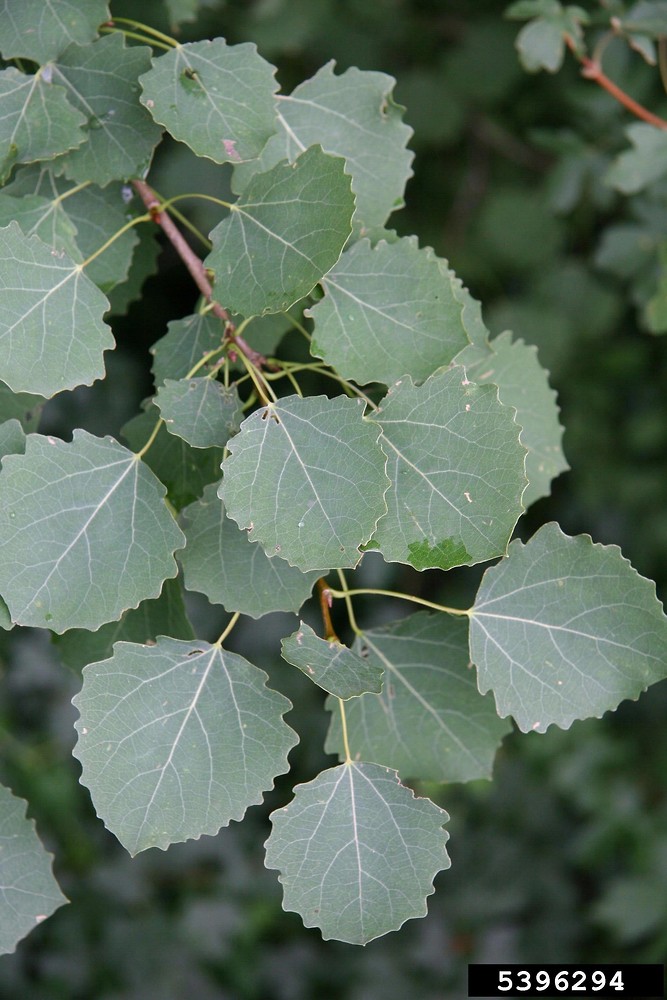Aspen (ASP)
Aspen sometimes called Eurasian aspen (Populus tremula) is one of two native poplar species to Britain; the other being black poplar (Populus nigra subsp. betulifolia). It is a species recognised for its important ecological role as a host for numerous species and said to have more host-specific species than any other boreal tree.
A fast-growing elegant tree that can reach 25 m. The grey bark is covered in distinctive diamond shaped lenticels and on a windy day the tree can often be heard before seen with its distinctive rustling, shimmering leaves which provide its other common name, quaking aspen.
An important timber tree in parts of mainland Europe in Britain it mainly fills an ecological role in forest diversification or as a species for quick growing short rotation forestry. Increasing interest in planting suggests a need for further research into its potential as a productive forest species in Britain.
Aspen is a native tree and is categorised as a secondary tree species. This is a species whose performance in trial plots has demonstrated promising silvicultural characteristics, but gaps in our knowledge constrain wider use. Such species are being actively evaluated to increase our understanding and inform future deployment.





Range
Native to Britain and widespread in northern and central Europe; it is sometimes grown from seed but is more often propagated from root cuttings or sometimes through micropropagation.
Provenance Choice
Experiments evaluating a range of Scottish clones have shown good survival and reasonable growth from native material. In addition, hybrids between P. tremula and the North American P. tremuloides produced in breeding programmes in northern Europe have shown vigorous growth and good form in recent trials.
Site Requirements
Aspen is a light demanding and fast-growing pioneer species which often grows in mixture with various broadleaves or on the fringes of conifer forests. Grows on a wide range of sites from slightly dry to wet soil moisture and of poor to rich soil nutrient status. Moderately tolerant of exposure and is cold hardy and frost resistant.
Further detail on the site requirements of aspen in current and future climates can be examined using the Forest Research Ecological Site Classification Decision Support System (ESC).
ECOLOGICAL SITE CLASSIFICATION TOOL
Silviculture
Interest in this species is for two main reasons, either as a fast-growing broadleaved species grown on short rotations (20-30 years) when afforesting agricultural land, or to increase the biodiversity of planted conifer forests, especially in upland Britain. In both cases, successful establishment will depend upon careful protection against deer since aspen is a favoured browse species. It is a light demanding species which typically colonises open ground after disturbances such are harvesting or fire.
When planted for short rotation forestry, a customary target density is around 1500 stems ha-1, planted into cultivated ground which is kept weed free during the first years. Canopy closure can occur by 10-15 years and no thinning takes places before final harvesting. Following felling, the successor stand is established from the copious root suckers that develop, and which are respaced when 2-3 m tall to the desired density.
Experience of using aspen to diversify upland conifer forests is still limited, but its introduction should be in discrete groups of at least 0.5 ha in size to ensure effective establishment, protection against browsing, and long-term persistence in the conifer matrix. The fast early height growth of aspen means that it could theoretically be used in mixture with species like Sitka spruce, and its frost tolerance suggests that it could be a nurse species to more sensitive conifer species. Two storied stands where aspen is colonised by more shade tolerant conifers are found in various boreal regions.
Most existing stands of aspen are small and are perpetuated through root suckers which may spread a considerable distance. Natural regeneration is reported to be rare, although viable seed has been found in Scottish stands. Productivity of over 16 m3 ha-1 yr-1 in trials of hybrid aspen has been reported from Scandinavia, but little long-term information is yet available in Britain. This species is unlikely to be affected by climate warming and therefore warrants consideration as a component of future forests in Britain.
Pests and Pathogens
Aspen can be attacked by leaf rusts (Melampsora spp.) which can result in serious defoliation while older and larger trees can be killed by the stem rot (Phellinus tremulae). Bacterial canker can also seriously damage certain clones.
See our other tools and resources
Further Resources
External
In addition to the general sources of information for species the following are useful for aspen.
Caudullo, G., de Rigo, D., 2016. Populus tremula in Europe: distribution, habitat, usage, and threats. In: San-Miguel-Ayanz, J., de Rigo, D., Caudullo, G., Houston Durrant, T., Mauri, A. (Eds.), European Atlas of Forest Tree Species. Publ. Off. EU, Luxembourg, pp. e01f148+
Savill, P., Stokes, V., Jinks, R., Mason, W.L. and Wilson, S.McG. (2018) Hybrid poplars and aspens. Quarterly Journal of Forestry, 112, 237-248.
Worrell, R. (1995) European aspen (Populus tremula L.): a review with particular reference to Scotland II. Values, silviculture and utilization. Forestry, 68:231-243.
Worrell, R., Gordon, A.G., Lee, R.S., and McInroy, A. (1999) Flowering and seed production of aspen in Scotland during a heavy seed year. Forestry, 72, 27-34.




